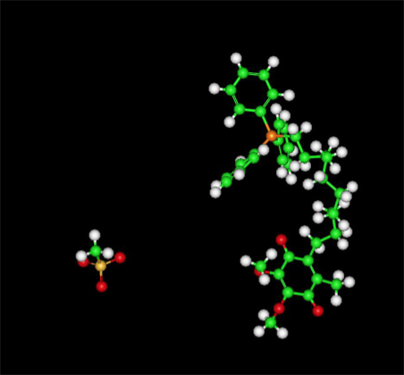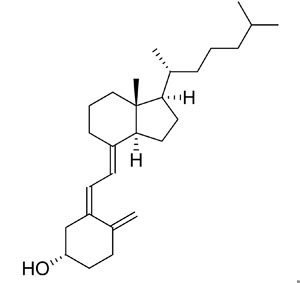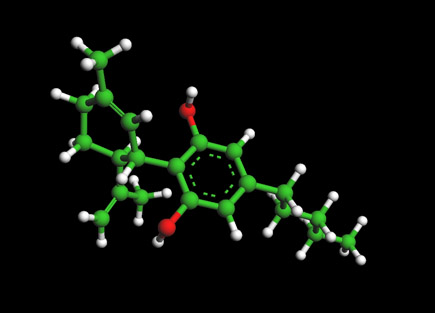Vitamin D3--Anti-Aging and Senolytic Properties

Image: MitoQ - Ball and Stick Model
To View the Viamin D3 Molecule in 3D --->> with Jsmol
Vitamin D is a group of fat-soluble secosteroids responsible for increasing intestinal absorption of calcium, magnesium, and phosphate, and multiple other biological effects. In humans, the most important compounds in this group are vitamin D3 (also known as cholecalciferol) and vitamin D2 (ergocalciferol).

Vitamin D3 Molecular Structure
Vitamin D bioavailability: state of the art.
There has been renewed interest in vitamin D since numerous recent studies have suggested that besides its well-established roles in bone metabolism and immunity, vitamin D status is inversely associated with the incidence of several diseases, e.g., cancers, cardio-vascular diseases, and neurodegenerative diseases. Surprisingly, there is very little data on factors that affect absorption of this fat-soluble vitamin, although it is acknowledged that dietary vitamin D could help to fight against the subdeficient vitamin D status that is common in several populations. This review describes the state of the art concerning the fate of vitamin D in the human upper gastrointestinal tract and on the factors assumed to affect its absorption efficiency. The main conclusions are: (i) ergocalciferol (vitamin D2), the form mostly used in supplements and fortified foods, is apparently absorbed with similar efficiency to cholecalciferol (vitamin D3, the main dietary form), (ii) 25-hydroxyvitamin D (25OHD), the metabolite produced in the liver, and which can be found in foods, is better absorbed than the nonhydroxy vitamin D forms cholecalciferol and ergocalciferol, (iii) the amount of fat with which vitamin D is ingested does not seem to significantly modify the bioavailability of vitamin D3, (iv) the food matrix has apparently little effect on vitamin D bioavailability, (v) sucrose polyesters (Olestra) and tetrahydrolipstatin (orlistat) probably diminish vitamin D absorption, and (vi) there is apparently no effect of aging on vitamin D absorption efficiency. We also find that there is insufficient, or even no data on the following factors suspected of affecting vitamin D bioavailability: (i) effect of type and amount of dietary fiber, (ii) effect of vitamin D status, and (iii) effect of genetic variation in proteins involved in its intestinal absorption. In conclusion, further studies are needed to improve our knowledge of factors affecting vitamin D absorption efficiency. Clinical studies with labeled vitamin D, e.g., deuterated or (13)C, are needed to accurately and definitively assess the effect of various factors on its bioavailability. see full publication
How Aging affects Vitamin D3 formation in humans
Jun 1 2014--Vitamin D and Aging
Aging affects the formation of 1,25-dihydroxyvitamin D (1,25[OH]2D; calcitriol), the active form of vitamin D. Production of 1,25(OH)2D is reduced by 50% as a result of an age-related decline in renal function, although serum 1,25(OH)2D levels are maintained in part by secondary hyperparathyroidism. Aging also causes a decrease in calcium absorption that precedes the decrease in 1,25(OH)2D by 10 to 15 years. Because 1,25(OH)2D is dependent on an adequate supply of the substrate vitamin D, the development of vitamin D deficiency leads to further reduction in the formation of 1,25(OH)2D. Measurement of the metabolite 25OHD provides the most widely used assessment of vitamin D deficiency. A serum 25OHD level lower than 10 ng/mL (25 nmol/L) represents vitamin D deficiency and leads to a reduction in serum 1,25(OH)2D. Vitamin D deficiency, is uncommon in North America, probably because of supplementation of dairy products and other foods with vitamin D. Sunlight exposure increases serum 25OHD levels by about 10 ng/mL during the months of April through September, resulting in low serum 25OHD for about 3 to 4 months in winter, with 2 additional months of low levels in more northern latitudes, such as Canada, and 2 fewer months in the southern states. Vitamin D supplementation in the winter can prevent vitamin D deficiency. Vitamin D insufficiency has been defined by the Institute of Medicine as a serum 25OHD level lower than 20 ng/mL (and >10 ng/mL). A serum 25OHD level lower than 20 ng/mL is associated with an increased fracture rate and increased rate of bone loss and treatment. Although other diseases have been associated with low serum 25OHD levels, the evidence for a causative role has not yet been established. Treatment of elderly people with vitamin D 800 IU daily will increase serum 25OHD levels to higher than 20 ng/mL and reduce fractures; this is particularly important in institutionalized people. see full publication
Vitamin D3 and Anti- Aging
2 December 2014 The Role of Vitamin D in the Aging Adult
The number of individuals aged 65 and older is expected to more than double from 2012 to 2060. The role of vitamin D in the prevention and treatment of diseases associated with aging has not been well studied. Traditionally, the role of vitamin D focused on the maintenance of skeletal health in the older adult. With the discovery of vitamin D receptors in the nervous, cardiovascular and endocrine systems, the role of vitamin D and its impact on these systems has become an important area of research. Older adults are at risk for lower levels of vitamin D as a result of decreased cutaneous synthesis and dietary intake of vitamin D. Epidemiologic evidence indicates an association between low levels of vitamin D and diseases associated with aging such as cognitive decline, depression, osteoporosis, cardiovascular disease, hypertension, type 2 diabetes, and cancer. Clinical trials to determine the benefit of vitamin D supplementation in preventing and treating such diseases are in progress. This paper highlights current evidence regarding the role that vitamin D may play in diseases associated with aging and addresses the need for well-designed randomized trials to examine its benefit on health outcomes in the older adult.
Anti-Aging and Senolytics Home Page
- What is Anti-Aging Medicine
- What is Senescence?
- What are Senolytics?
- About Caloric Restriction
- Mtor and Rapamycin
- The IKK/NF-κB signaling pathway in aging
- Exercise and Anti-Aging
- Meditation and Anti-Aging
SENOLYTIC AND ANTI-AGING MOLECULES
RAPAMYCIN ---The mechanistic target of rapamycin (mTOR) pathway has a central role in cell activation...
METFORMIN -- The diabetes drug metformin used by some for anti-aging may diminish benefits of aerobic exercise...
QUERCETIN-- AND WITH DASATINIB--The senolytic cocktail, dasatinib plus quercetin, which causes selective elimination of senescent cells...
FISETIN--Of the 10 flavonoids tested, fisetin was the most potent senolytic...
EGCG- The most active component of green tea....
NAD BOOSTERS --'...The cells of the old mice were indistinguishable from the young mice, after just one week of treatment...
SULFORAPHANE-- An isothiocyanate present in cruciferous vegetables activates antioxidant and anti-inflammatory responses by ...
UROLITHIN --Metabolite of Pomegranate compound with anti-aging effects passes human trial...
MITO-Q -- A water soluble fomr of CoQ10 that has excellent absorption and high bioavailability...
HONOKIOL - A bioactive natural product derived from Magnolia Bark have demonstrated ...
CURCUMIN AND ANALOGS -Recent research is focused on the design and synthesis of curcumin analogs as antiproliferative and anti-inflammatory agents...
BERBERINE --berberine has recently been reported to expand life span in Drosophila melanogaster, and attenuate premature cellular senescence
N-ACETYL-CYSTINE (NAC)--"...pretreatment with NAC increased glutathione levels in the older cells and largely helped offset that level of cell death..."
PIPERLONGUMINE - A natural product from the Long pepper with high bioavailability...
RESVERATROL AND PTEROTSILBINE -- Pterostilben chemically similar to resveratrol bute differs from resveratrol by exhibiting increased bioavailability (80% compared to 20% in resveratrol)
SPERMIDINE--Spermidine delays aging in humans ...
ALLICIN -- Allicin is a compound produced when garlic is crushed or chopped. ...
VITAMIN D3 -- Production of the active forms of Vitamin D are reduced by 50% as a result of an age-related decline
VITAMIN K-- evidence suggests vitamin K has an anti-inflammatory action
TOCOTRIENOL(AND WITH QUERCETIN) --Tocotrieniols have been found to exert a synergistic antitumor effect on cancer cells when given in combination....
HSP-90 INHIBITORS --As a novel class of senolytics
The Cannabidiol Molecule
Cannabidiol (CBD is the major non-psychoactive component of Cannabis and is being looked at by major drug and consumer companies for various medical and social uses.